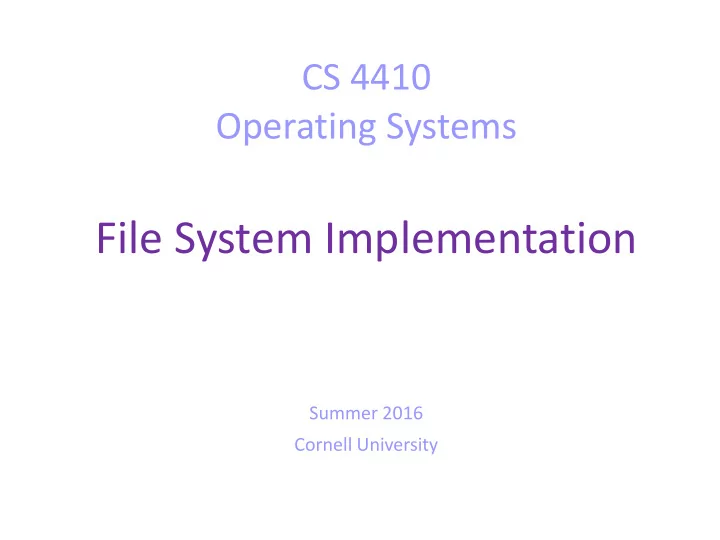

CS 4410 Operating Systems File System Implementation Summer 2016 Cornell University
Today • File allocation • Unix file system • Log-structured file system 2
File system: two design problems • User interface: – File, directory, attributes, allowed operations. • Hardware interface: – Map logical file system onto storage devices. – Manage free storage space. • Bit vector, • Linked list, …
File • Data of a file is mapped to several blocks in the storage device. • For each file, the OS maintains a structure FCB (file control block) with information about: – the location of data blocks, – size, – permissions, – o wner … • FCB is stored in yet another block.
Directory • The main function of a directory is to map the ASCII name of the file onto the information needed to locate the data. • A directory can be implemented as a list of entries. – Each entry is a pair of an ASCII name and an FCB. • Every time we open a file, which has not been opened yet in the system, – we find its directory and – search its entry. • A directory is stored in blocks, too. • The OS maintains an FSB for each directory.
Allocation Methods ● How do we allocate space (blocks) to the files so that: ● Disk space is utilized effectively. ● Files are accessed quickly. 6
Contiguous Allocation 7
Contiguous Allocation Each file occupy a set of contiguous blocks on the disk. ● Minimal disk seeks and seek time . ● The directory entry for each file indicates the address of the starting ● block and the number of blocks used . It supports both sequential and direct access. ● Difficulty in finding free space. ● Dynamic storage-allocation problem ● External fragmentation ● – Solution: Compaction Determine space needed for a file. ● 8
Linked Allocation 9
Linked Allocation ● A file is a linked list of disk blocks . ● The directory entry contains a pointer to the first and last blocks. ● Each block contains a pointer to the next block. They consume space. ● ● Easy block allocation. ● Effective only for sequentially-access files. ● Solution: Allocate clusters rater than blocks. ● Another Problem: Reliability 10
Indexed Allocation 11
Indexed Allocation ● Bring all the pointers together into the index block . ● The directory entry contains the address of the index block . ● It keeps the advantages of the Linked Allocation (no external fragmentation, flexible size-declaration). ● It supports efficient direct access . ● It suffers from wasted space. ● How large should the index block be? ● What happens if the pointers do not fit in one block? 12
Indexed Allocation ● Combined scheme ● Used in UFS ● The directory entry has a pointer to the file's inode. ● inode = FSB that saves additional 15 pointers. – 12 pointers point to direct blocks. – 1 pointer points to single indirect block. – 1 pointer points to double indirect block. – 1 pointer points to triple indirect block. 13
The Unix inode 14
The Unix inode • If blocks are 4K and block references are 4 bytes ... – First 48K reachable from the inode. – Next 4MB available from single-indirect . – Next 4GB available from double-indirect. – Next 4TB available through the triple-indirect block. • Any block (in 4TB space) can be found at 4 disk accesses.
Log-structured File System (LFS) • There is a gap between CPU speeds and disk access times. • Assumption: Files are cached in main memory. • So, disk traffic will be dominated by writes. • Write all new information to disk in a sequential structured called log. • This approach increases performance dramatically by eliminating almost all seeks. • Permanent storage. No other structure on disk. • For a log-structured file system to operate efficiently, it must ensure that there are always large extents of free space available for writing new data. This is the most difficult challenge. • Outperforms UFS by an order of magnitude for small writes. • Matches or exceeds UFS performance for reads and large writes.
LFS Block-level representation Logical file system of file system Inode map root Inode Dir data dir1 file2 File data file1 Disk layout empty space always at the end
LFS: write • Remember: even if a few bytes of a file are written/modified, the entire block that includes these bytes should be written/modified. • LFS treats a block that needs to be modified or written in the same way. – This block is written at the end of the log structure.
Assume that file data is modified and becomes . n n The inode of that file should change to point to the new data block. n The inode of that file is modified… n n In turn, the directory, its inode, and the inode map are modified… n n n n n always at the end Garbage collection n n n n n Cleaning (in segments) n n n n n
Today • File allocation • Unix file system • Log-structured file system 20
Coming up… • Next lecture: Networking – Introduction • HW4 is due on Tuesday • Exam on Thursday • Office hours moved from today to Tuesday.
Recommend
More recommend